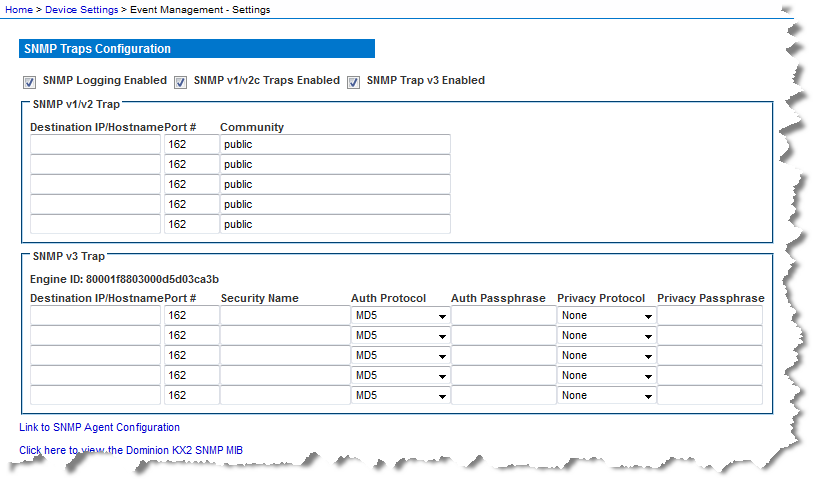Simple Network Management Protocol (SNMP) is a protocol governing network management and the monitoring of network devices and their functions.
SNMP traps are sent out over a network to gather information.
The traps are configured on the Event Management - Settings page. See List of KX III SNMP Traps for a list of KX III SNMP traps.
SNMP-compliant devices, called agents, store data about themselves in Management Information Bases (MIBs) and respond to the SNMP trap.
SNMP agents are configured on the Device Services page. See Configuring SNMP Agents for information on configuring SNMP agents and Viewing the KX III MIB for information on viewing the KX III MIB.
Once selected, all related fields are enabled. Required
Note: IPv6 addresses cannot exceed 80 characters in length for the host name.
Note: An SNMP community is the group to which devices and management stations running SNMP belong. It helps define where information is sent. The community name is used to identify the group. The SNMP device or agent may belong to more than one SNMP community.
Note: IPv6 addresses cannot exceed 80 characters in length for the host name.
Note: If you are accessing the Event Management - Settings page from the local console and are using a screen resolution lower than 1280x1024, the Privacy Passphrase column may not be displayed on the page. If this occurs, hide the KX III's left panel. See Left Panel
Use the Link to SNMP Agent Configuration link to quickly navigate to the Devices Services page from the Event Management - Settings page.
The events that are captured once an SNMP trap is configured are selected on the Event Management - Destination page. See Configuring Event Management - Destinations.
KX III supports SNMP logging for SNMP v1/v2c and/or v3. SNMP v1/v2c defines message formats and protocol operations when SNMP logging is enabled. SNMP v3 is a security extension of SNMP that provides user authentication, password management and encryption.
Note: If you disable SNMP settings at any time, the SNMP information is retained so you do not have to reenter if you re-enable the settings.

Use the reset to factory defaults feature to remove the SNMP configuration and set the KX III to its original factory default.
WARNING: When using SNMP traps over UDP, it is possible for the KX III and the router that it is attached to fall out of synchronization when the KX III is rebooted, preventing the reboot completed SNMP trap from being logged.